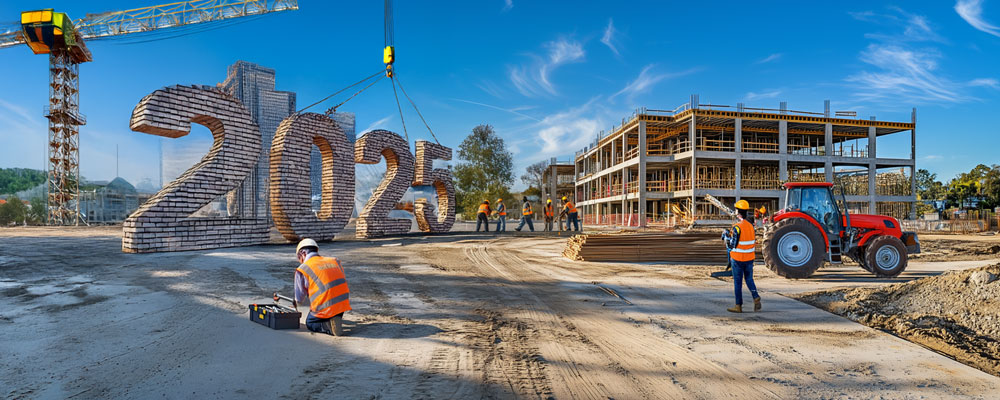
2025 Outlook: What Distributors Need to Know
Construction: the world’s largest industry, accounts for about 13% of global GDP. Yet, it’s notorious for its slow growth rate. In 2025, this sector is heading for a major shake-up—both promising and challenging.
Urbanization is driving demand for housing, infrastructure, and commercial developments, bolstered by efficiency improvements and potential interest rate declines. But the road ahead isn’t all smooth. Rising insolvencies, reduced public and private investment, and an ongoing labour shortage are casting shadows. Here’s our break down of the key trends that you, as distributors, need to know to stay competitive.
1. Material Costs: Skyrocketing, Not Stopping
If you’re feeling the pinch of rising material prices now, brace yourself—2025 won’t be kinder. Key building materials like steel, concrete, timber, and insulation are climbing in cost due to supply chain disruptions, increased demand, and environmental regulations.
- Steel: Prices are volatile, impacted by tariffs and energy costs.
- Concrete: Eco-friendly innovations are pushing prices up, thanks to sustainable production techniques.
- Timber: High demand and international supply chain hiccups are keeping prices elevated.
- Insulation: Green building trends mean these materials are in hot demand, and prices reflect it.
For distributors, finding reliable suppliers and managing costs will be crucial to survival.
2. Tech Adoption: The Game-Changer
Technology in construction isn’t just a buzzword; it’s becoming a lifeline. Virtual Design and Construction (VDC) tools like Building Information Modelling (BIM) allow firms to map out projects digitally before breaking ground. That’s big news for slashing rework costs (an industry-wide 30% pain point) and keeping projects on budget.
And then there’s 3D printing, which is evolving rapidly. Currently, it’s focused on frames and walls, but plumbing and electrical fixtures may soon be printed directly into structures. It’s costly upfront, sure, but the long-term payback in speed and precision makes it hard to ignore.
Robotics is also stepping up, tackling labour shortages and improving safety while reducing waste. Early adopters of these innovations will gain a massive edge over slower competitors.
3. Modular and Prefabricated Construction: Speed Meets Savings
Modular construction—where up to 90% of a building is assembled off-site—is revolutionizing how we build. Prefabrication (assembling components off-site) makes installation seamless. By 2027, the modular construction market is projected to hit $120 billion, up from $91 billion in 2022.
For distributors, this trend means a shift toward supplying pre-made components. It’s faster, more efficient, and a significant cost saver for builders aiming to hit tight deadlines.
4. Green Building: A Sustainability Surge
Green building is no longer optional; it’s a mandate. Construction contributes 11% of global greenhouse gas emissions, with cement alone responsible for 8%. Regulatory pressure, particularly in the UK, is driving firms to adopt environmentally friendly practices like using sustainable materials and energy-efficient designs.
- Net-zero carbon goals: The UK government’s target of net-zero emissions by 2050 is shaping policies. Expect stricter regulations in 2025.
- The payoff: While green building materials and designs might increase upfront costs, they promise long-term savings in energy efficiency and operational costs.
For businesses, the message is clear: go green or risk being left behind.
5. The Workforce Dilemma
Here’s the stark reality: the UK construction sector needs an additional 251,500 workers by 2028 to meet demand. Labor shortages are pushing up wages and forcing firms to invest more in training and retention. For distributors, this could mean longer lead times as contractors struggle to maintain project schedules.
Automation and robotics are stepping in to fill the gap, but it’ll take time to bridge the divide. In the meantime, labour shortages will continue to drive up overall project costs.
6. New Government Initiatives
The UK’s new Labour government has ambitious plans: 150 major infrastructure projects and 1.5 million new homes by 2029. Streamlined approval processes are expected to speed up some projects, but with nearly £4 billion in road-building projects scrapped, not all sectors will feel the benefits.
Regulatory changes like the Building Safety Act and tougher energy efficiency standards are also on the horizon. While these may increase compliance costs, they will drive better quality and safer buildings.
7. Residential Sector: A Rocky Road
The residential sector remains the hardest-hit segment, particularly new builds. Rising interest rates have made mortgages less accessible, cooling demand for housing. On the flip side, commercial construction is expanding rapidly, according to recent data from the November 2024 Purchasing Managers’ Index.
Conclusion
The year 2025 will be a different beast for construction. Rising costs, green mandates, labour shortages, and tech adoption are shaping the industry’s trajectory. While these shifts present challenges, they also bring opportunities for those who adapt quickly.
- For distributors: Focus on streamlining supply chains, securing reliable material sources, and staying ahead of tech trends.
- For contractors: Invest in tech, embrace modular methods, and prioritize green building practices.
Ultimately, the construction sector is moving toward a smarter, greener, and more efficient future. The businesses that lean into these changes will thrive, while those that resist risk falling behind.
continue reading






